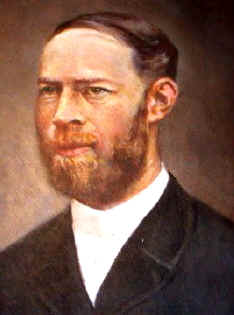Heinrich Rudolph Hertz (1857 - 1894)
 Heinrich
Rudolf Hertz was born in Hamburg, Germany. His father was a prominent lawyer
and legislator. In his youth Heinrich enjoyed building instruments in the family
workshop. Hertz began his college studies at the University of Munich. After
a short time he transferred to the University of Berlin, where he received his
Doctor of Philosophy degree magna cum laude. In Berlin he was an assistant to
Hermann von Helmholtz, one of the
foremost physicists of the time. In 1883 Hertz became a lecturer in theoretical
physics at the University of Kiel. Two years later he was appointed professor
of physics at Karlsruhe Polytechnic. In the 1880s physicists were trying to
obtain experimental evidence of electromagnetic waves. Their existence had been
predicted in 1873 by the mathematical equations of James Clerk Maxwell, a British
scientist. (portrait
courtesy)
Heinrich
Rudolf Hertz was born in Hamburg, Germany. His father was a prominent lawyer
and legislator. In his youth Heinrich enjoyed building instruments in the family
workshop. Hertz began his college studies at the University of Munich. After
a short time he transferred to the University of Berlin, where he received his
Doctor of Philosophy degree magna cum laude. In Berlin he was an assistant to
Hermann von Helmholtz, one of the
foremost physicists of the time. In 1883 Hertz became a lecturer in theoretical
physics at the University of Kiel. Two years later he was appointed professor
of physics at Karlsruhe Polytechnic. In the 1880s physicists were trying to
obtain experimental evidence of electromagnetic waves. Their existence had been
predicted in 1873 by the mathematical equations of James Clerk Maxwell, a British
scientist. (portrait
courtesy)
In 1887 Hertz tested Maxwell's hypothesis. He used an oscillator made of polished brass knobs, each connected to an induction coil and separated by a tiny gap over which sparks could leap. Hertz reasoned that, if Maxwell's predictions were correct, electromagnetic waves would be transmitted during each series of sparks.
To confirm this, Hertz made a simple receiver of looped wire. At the ends of the loop were small knobs separated by a tiny gap. The receiver was placed several yards from the oscillator. According to theory, if electromagnetic waves were spreading from the oscillator sparks, they would induce a current in the loop that would send sparks across the gap. This occurred when Hertz turned on the oscillator, producing the first transmission and reception of electromagnetic waves. Hertz also noted that electrical conductors reflect the waves and that they can be focused by concave reflectors. He found that nonconductors allow most of the waves to pass through. Another of his discoveries was the photoelectric effect. In 1889 Hertz was appointed professor of physics at the University of Bonn. (reference)
Hertz opened the way for the development of radio, television, and radar with his discovery of electromagnetic waves between 1886 and 1888. James Clerk Maxwell had predicted such waves in 1864. Hertz used a rapidly oscillating electric spark to produce waves of ultrahigh frequency. He showed that these waves caused similar electrical oscillations in a distant wire loop. He also showed that light waves and electromagnetic waves were identical (see Electromagnetism). Hertz was born in Hamburg.
Heinrich Hertz was posthumously recognized for his contributions to research in the field of electromagnetics by the International Electrotechnical Commission in 1930 by having the unit of measurement of frequency name hertz. This unit replaced the earlier used measurement of cycles per second and was in widespread used by the 1970s. Today the unit hertz is used in everything from radio broadcasting to measuring the frequency of light reflected by printer inks to measuring the speed of computer processing chips and much much more.

Connect with us
Contact us today